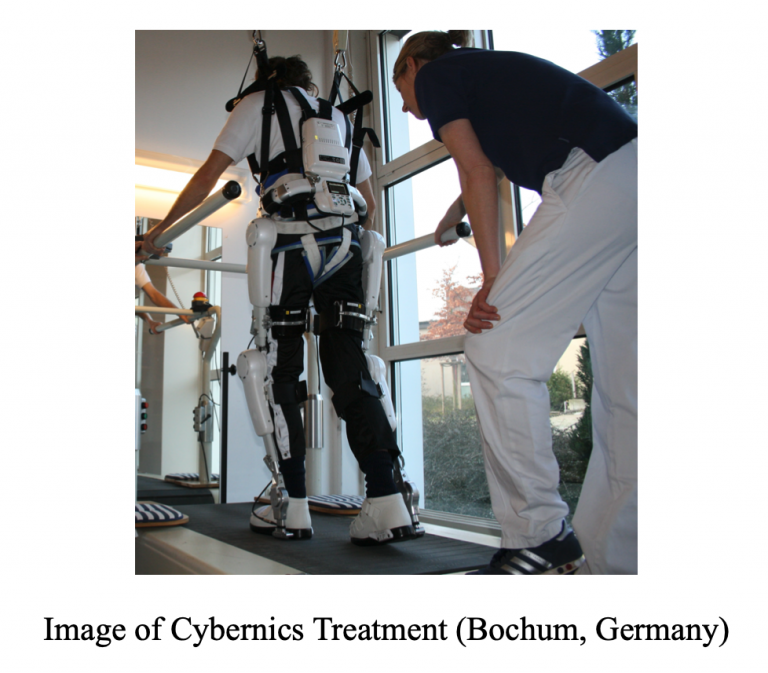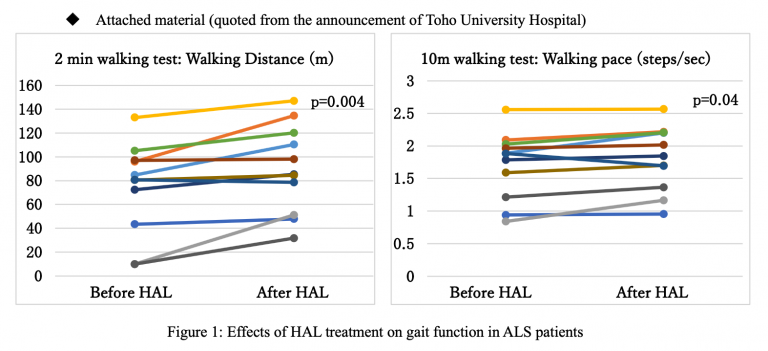![]()
2022-03-17 updated
CYBERDYNE Inc. (Tsukuba, Ibaraki, Japan, President & CEO: Yoshiyuki Sankai) announced today that the results of its research on the HAL for Medical Use Lower Limb Type (hereafter “Medical HAL”) had been published in the online edition of the Journal of Clinical Neuroscience*1. A research group from Toho University School of Medicine has conducted one phase (total of nine sessions, 2-3 sessions per week, 1-2 months) of Cybernics Treatment™*2 with Medical HAL and found the treatment method to be effective for improving the walking function of Amyotrophic Lateral Sclerosis (“ALS”) patients, a progressive neurodegenerative where no effective treatment methods were available to prevent the muscles from getting weaker.

◆ Authors
Harumi Morioka (Department of Neurology, Toho University Faculty of Medicine)
Takehisa Hirayama (Department of Neurology, Toho University Faculty of Medicine)
Satoru Ebihara (Department of Rehabilitation Medicine, Toho University Faculty of Medicine)
Osamu Kano (Department of Neurology, Toho University Faculty of Medicine)
◆ Key findings
● Cybernics Treatment™ was effective towards ALS for improving patients’ gait function.
● Although there are therapeutic agents that suggest delaying the progress of ALS, there are no treatments methods that improve the motor functions of ALS patients.
● By maintaining and improving the gait function, the QoL of ALS patients is also expected to improve.
◆ Outline of the research (quoting the announcement of Toho University)
ALS is a progressive neurodegenerative disease that affects motor neurons in the brain, spinal cord, and other body parts. If motor neurons are affected by the disease, the muscles that move limbs, swallow, speak, and breathe become emaciated, causing muscle weakness. The prognosis is short, ranging from three to five years, and because there is no treatment to stop the progression of the disease, it is also called “the most intractable disease.” While Riluzole and Edaravone are covered by insurance as therapeutic agents, they do not improve muscle weakness or emaciation, making it difficult for patients to feel the benefits. In 2018, the Department of Neurology, Division of Internal Medicine, Toho University School of Medicine introduced medical HAL to treat ALS to improve walking function. In Japan, treatment with HAL towards eight types was covered by insurance in April 2016 for neuromuscular diseases, including ALS. However, many were hoping for further research on the disease, as the trial only included one ALS patient out of 24 patients.
The study included 11 patients diagnosed with ALS at Toho University Hospital who received treatment between January and December 2019. All 11 patients recruited for the study could not walk independently safely for more than 10 meters but could walk for more than 10 meters with assistance or walking aids. The evaluation method included one period of HAL Treatment (total of 9 sessions, frequency 2-3 times/week, for 1-2 months, duration: 20-40 minutes, excluding putting-on HAL to the patient and breaks). 2-minute walking distance, 10-meter walking test (assessing speed, stride length, and walking rate), ALS motor function rating scale (ALSFRS-R), Barthel Index (BI), functional independence measure (FIM), and effort lung capacity were observed and analyzed before and after each treatment sessions. As a result, the average walking distance increased from 73.87 m before treatment to 89.94 m after treatment (p=0.004). The mean walking rate for the 10-meter walk also improved from 1.71 before treatment to 1.81 after treatment (p=0.04) (Figure 1). Although no significant differences were observed, the speed and stride length of the 10-meter walk also tended to improve, and the ALSFRS-R, BI, and FIM were maintained. Walking dysfunction decreases ADL and quality of life in ALS patients. Continued HAL treatment may keep and improve gait function, and future research results are awaited.

◆ Accepted journal
Name of the journal: Journal of Clinical Neuroscience (March 11, 2022)
Title: Robot-assisted training using Hybrid Assistive Limb ameliorates gait ability in patients with amyotrophic lateral sclerosis
Author: Harumi Morioka Takehisa Hirayama, Tatsuki Sugisawa, Kiyoko Murata, Mari Shibukawa, Junya Ebina, Masahiro Sawada, Sayori Hanashiro, Junpei Nagasawa, Masaru Yanagihashi, Masayuki Uchi, Kiyokazu Kawabe, Naohiro Washizawa, Satoru Ebihara, Takashi Nakajima, Osamu Kano*
DOI Number: 10.1016/j.jocn.2022.02.032
URL: https://www.sciencedirect.com/science/article/pii/S0967586822000856
◆ Comments by Prof. Osamu Kano
There is a worldwide race to develop and conduct clinical trials for drugs that will inhibit the progression of ALS, but most of them have failed to meet expectations. Even in conventional treatment, including rehabilitation, the main focus is on maintaining muscle strength, and there is almost no report of improvement. The results of this study using a medical device, “HAL,” surprisingly exceeded expectations and brought a glimmer of hope.
Although this study was a short-term observational study of one to two months, our group has already published a paper on the effects of long-term HAL treatment in a small number of cases, which is in the process of being accepted for publication. In the future, it will be necessary to accumulate more cases of HAL treatment to verify the effect of prolonging life expectancy and the effect on the quality of life (QOL) and the maintenance of walking function over the long term.
We want to take this opportunity to express our deep appreciation for the cooperation of Dr. Tatsuki Sugisawa, a rehabilitation therapist, and the entire staff of the Toho University ALS Clinic in helping to achieve the results of this study.
Reference: Press release by Toho University (available in Japanese only)
https://www.toho-u.ac.jp/press/2021_index/20220317-1194.html
*1 The Journal of Clinical Neuroscience is a peer-reviewed medical journal published bimonthly, covering the fields of neurosurgery and neurology. It was founded in 1994 and is published by Churchill Livingstone, an Elsevier publisher.
*2 Cybernics Treatment™ is a treatment that uses Wearable Cyborg™, HAL to improve/regenerate the function of the wearer. The treatment targets spinal cord injury, stroke, neuromuscular diseases, etc. When a person tries to move their body, nerve signals are transmitted from the brain to the muscles via motor neurons, causing the musculoskeletal system, including joints, to move. Just before the body movement, faint “bio-electrical signals” that reflect a person’s intention leak out to the skin surface. HAL can read this signal and control the power unit to assist joint movement in unison with the person. By using Wearable Cyborg HAL™, which utilizes the bio-electrical signal that reflects the wearers’ intended motion, interactive biofeedback is promoted in and outside of the body between HAL, brain, nervous system, and muscular system. Cybernics Treatment is based on this iBF theory (interactive bio-feedback theory). The effect of this treatment method to promote functions of the lower limb, upper limb, and body trunk is being reported through clinical application. In other words, the key to promoting functional improvement through Cybernics Treatment™ is not just transmitting voluntary command signals from the human brain to the musculoskeletal system via the spinal cord and peripheral nerves, but more so on the return of feedback from the sensation of actual movement to the human brain. The functional improvement/regeneration technology using HAL based on this iBF Theory is an innovative treatment technology that enables improvement/regeneration of human brain-nerve-musculoskeletal functions by activating the body’s self-healing ability that humans are naturally in possession of.
© 2025 CYBERDYNE INC. ALL RIGHTS RESERVED.